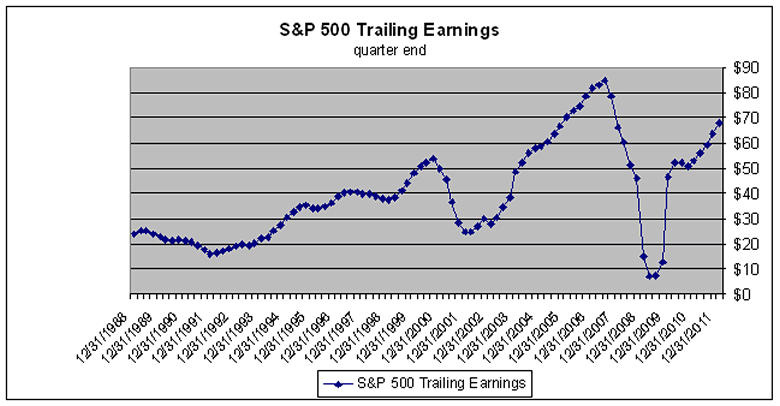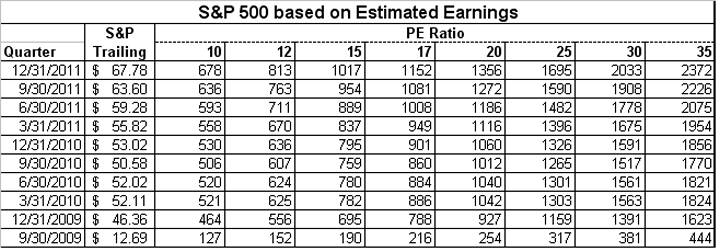Stock Market S&P 500 Price Earnings Forecast 2010 to 2011
Stock-Markets / Investing 2010 Dec 16, 2009 - 02:04 PM GMTBy: Hans_Wagner
 The S&P 500 PE ratio is the primary measure used by many investors to value the stock market and assess S&P 500 trend. Historically, the S&P 500 PE ratio has a median of 15.7. As of September 30, 2009, the S&P PE ratio was 86 based on a closing price of 1057 and trailing annual earnings of the S&P 500 of $46.36. All numbers are from the Standard & Poor’s S&P 500 index reporting. Part of the reason the PE ratio is so high is the negative affect of earnings in the December 2008 and March 2009 quarters. After the recent market rally, what should investors expect for 2010?
The S&P 500 PE ratio is the primary measure used by many investors to value the stock market and assess S&P 500 trend. Historically, the S&P 500 PE ratio has a median of 15.7. As of September 30, 2009, the S&P PE ratio was 86 based on a closing price of 1057 and trailing annual earnings of the S&P 500 of $46.36. All numbers are from the Standard & Poor’s S&P 500 index reporting. Part of the reason the PE ratio is so high is the negative affect of earnings in the December 2008 and March 2009 quarters. After the recent market rally, what should investors expect for 2010?
Investors look forward when they think about where the markets will be. The S&P 500 PE ratio reflects this view and it helps to explain the sudden spike in the S&P 500 PR ratio in the chart below. After earnings for the S&P 500 companies fell off a cliff, investors anticipated the market would recover, leading to the record high PE ratio for the S&P 500.
As of the September 2009 quarter the S&P PE ratio remains very high at 86, as the trailing four quarters of earnings still include the earnings of -$23.25 in December 2008 and $7.52 in March 2009 quarters. Using data from Standard & Poor’s for the S&P 500, as reported earnings for 98% of all reporting companies, creates an S&P 500 PE ratio of 86.34 as of September 30, 2009. The trailing four quarters of earnings was $12.69. As a point of reference, the annual trailing earnings for the S&P 500 two years ago was $78.60 for the September 2007 quarter with a 17.70 S&P 500 PE ratio. The plunge in earnings during the recession caused the S&P 500 PE ratio to leap to its high.
As shown on the chart below, the S&P 500 PE ratio is forecast to fall just above 16 by the end of 2011. The S&P PE ratio estimates are from Standard & Poor’s.

S&P 500 Earnings Forecast
Standard & Poor's prepares an earnings forecast through the end of 2011 for the S&P 500. The chart below shows actual trailing annual earnings since the June 1990 through September 2009. It also includes the forecast for earnings through December 2011.
What stands out is the sudden jump in earnings that begins with the quarter ending December 2009. Part of this sudden change is the large drop in earnings reported for December 31, 2008 is no longer part of the trailing earnings. For the quarter ending December 31, 2008 the S&P 500 delivered $23.25 in losses for that quarter alone due to the large write-offs in the financial sector.
Once the major write-offs are no longer part of the four quarter trailing earnings, the annual earnings return to a forecasted $46.36 for the S&P 500. In addition, Standard & Poor's has raised their forecast for earnings for 2010 from $45.84 three months ago to $53.02 currently. Part of this increase is due to better earnings in the third quarter of 2009. We need to remember that the bulk of earnings improvement came from cost cutting, as revenue growth was minimal. For earnings to expand as forecast, we will need to see revenues expand significantly.

S&P 500 PE Ratio Forecast
In the recession of 1990 – 1991, the S&P index began to climb before the end of the recession. Following the end of the 2001 recession, the S&P 500 fell another 200 points before rebounding. So far in the recession of 12/2007 - September 2009, the S&P 500 fell significantly and rallied through November 2009.

Using the S&P 500 earnings forecast from Standard & Poor’s, we can assess and forecast the S&P 500 index through 2011.
Using the trailing four-quarter earnings from Standard & Poor's, we can apply a PE ratio to derive the S&P 500 index forecast. Keep in mind that the median PE ratio is 15.7. Moreover, the PE ratio is mean reverting, so we should expect it to migrate toward that level or lower.

Using the December 2009 quarter, the earnings forecast $46.36, and a PE ratio of 25 gives us a target price for the S&P 500 index of 1,159. On Wednesday December 9, 2009, the S&P closed at 1,096. A PE ratio of 20 gives us an S&P 500 index of 927. If the S&P 500 PE ratio remains between 20 and 25, we should see the S&P 500 index climb to a range of 1,060 to 1,326 in 2010 and 1356 to 1695 in 2011.
Now look back at the forecast for the S&P 500 PE ratio through 2011. It is the first chart in this article. Notice that the PE ratio declines slowly reaching 16.16 by the end of 2011. From the table above, apply a PE of 15 to 17 and you get an S&P 500 forecast range for the end of 2011 of 1017 to 1152, about where we are now.
In other words, in order for the S&P 500 index to climb much further the S&P 500 PE ratio must remain in the 20 - 25 range. History tells us that this is unlikely. We are more likely to see the S&P PE ratio fall from its current level even as earnings rise.
How should investors proceed from here? Standard & Poor's as well as other firms have increased their forecast for earnings in 2010. Should these earnings forecasts rise again, it will help push the S&P 500 index up. We will need to monitor earnings results and changes in the forecast throughout the year to get a better idea of the trend in earnings.
Second, evaluate your PE ratio assumptions based on the outlook for the economy and the markets. If earnings are running above the forecast from Standard & Poor’s, then we might expect the PE ratio to stay closer to 20. On the other hand, if earnings expectations are falling, then the PE ratio could move toward 15 faster. In each case, the S&P 500 PE ratio is likely to move down over time.
Yale University Professor Robert J. Shiller, author of Irrational Exuberance: Second Edition![]() uses a modified PE ratio that smoothes out the volatility in the ratio. The denominator of this modified ratio is average inflation-adjusted earnings over the trailing 10 years. Shiller calls this modified ratio "p/e10." Using this data the modified ratio “p/e10” produces a PE ratio of slightly over 15, which is very close to the median of 15.7. In December 2007, the beginning of the current recession, the “p/e 10” was 25.95. Since markets tend to cycle above and below the median, we should expect the “p/e 10” to fall further before turning back up.
uses a modified PE ratio that smoothes out the volatility in the ratio. The denominator of this modified ratio is average inflation-adjusted earnings over the trailing 10 years. Shiller calls this modified ratio "p/e10." Using this data the modified ratio “p/e10” produces a PE ratio of slightly over 15, which is very close to the median of 15.7. In December 2007, the beginning of the current recession, the “p/e 10” was 25.95. Since markets tend to cycle above and below the median, we should expect the “p/e 10” to fall further before turning back up.
Using December 2010 trailing four-quarter earnings forecast of $53.02 times the median PE ratio of 15.7 gives us an S&P 500 index of 832. From this perspective, the risk is to the down side.
Either approach tells us to expect the S&P 500 PE ratio to trend down. An expansion in the S&P PE ratio will not come along to help the market. Bargains will be harder to find and real sustainable earnings growth will be even more important. Earnings must come from revenue growth.
More likely, we are entering a period where the market, as defined by the S&P 500, will be range bound with 1200 on the high side and maybe 900 on the low side. This range will give plenty of opportunity for stock pickers and anyone willing to buy on the pullbacks, an opportunity to bet the market. It will not help the buy and hold crowd.
If you wish to learn more on evaluating the market cycles, I suggest you read:
Ahead of the Curve: A Commonsense Guide to Forecasting Business and Market Cycles by Joe Ellis is an excellent book on how to predict macro moves of the market.
Unexpected Returns: Understanding Secular Stock Market Cycles by Ed Easterling. One of the best, easy-to-read, study of stock market cycles of which I know.
The Disciplined Trader: Developing Winning Attitudes by Mark Douglas. Controlling ones attitudes and emotions are crucial if you are to be a successful trader.
By Hans Wagner
tradingonlinemarkets.com
My Name is Hans Wagner and as a long time investor, I was fortunate to retire at 55. I believe you can employ simple investment principles to find and evaluate companies before committing one's hard earned money. Recently, after my children and their friends graduated from college, I found my self helping them to learn about the stock market and investing in stocks. As a result I created a website that provides a growing set of information on many investing topics along with sample portfolios that consistently beat the market at http://www.tradingonlinemarkets.com/
Copyright © 2009 Hans Wagner
Hans Wagner Archive |
© 2005-2022 http://www.MarketOracle.co.uk - The Market Oracle is a FREE Daily Financial Markets Analysis & Forecasting online publication.



